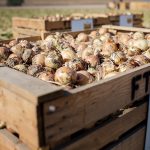Our friend Kim Reddin, director of public and industry relations for the National Onion Association, presented a terrific multi-media look at onion retail sales trends during the recent NOA Summer Convention in Richland, WA.
Kim has graciously provided us with some excerpts from her presentation, with an explanation of the who’s and how’s of the study.
She said the convention provided opportunity to, for the first time in her tenure with the NOA, to “give members a snapshot of retail sales trends for the dried onion category” that resulted from a collaborative agreement between the Vidalia Onion Committee and the NOA. Foodservice trends were also presented.
About Nielsen FreshFacts pertaining to retail, Kim said, “This data specifically shows onions sold using UPC codes and by the pound. Naturally, point-of-purchase data is a measurement of past performance and does not account for production volume fluctuations. The value is being able to see volume and price trends within a 52-week period for a category. This is one way of understanding consumers and measuring the categories performance.”
And about foodservice data shown by Datassential Menu Trends™, she explained, “Menu trends provide one of the best insights to what foodservice operators are putting on their menus. NOA has purchased a number of studies over the years to gauge where onion usage at foodservice is occurring. NOA purchased this recent study from Datassential Menu Trends™ this spring.”
Kim wrote that retail highlights indicate that “for the 52-week period ending October 2016, the dried onion category sales increased 4.7 percent, and volume was up 3 percent compared to the previous year. The volume of sweet onions was up 9 percent.”
Also, more than two-thirds of dried onion sales are yellow and sweet onions. And of all segments – yellow, sweet, red, white, shallots, pearl and other – red onion sales increased the most, up 12.8 percent during that 52-week period. Total dried onions dollar and volume sales peaked in January 2016.
“This seemed a bit unusual for sales to peak in January,” she wrote. But she added, “When I compared to Ag Marketing Service data, I was able to verify this is a fairly consistent trend over the last 10 years. Could this explain the slump in sales the industry experiences in February?”
In the foodservice sector, Kim highlighted menu trends and noted, “Onions are the most commonly mentioned vegetable on menus.”
A whopping 93 percent of operators menu onions, and the highest incidence of onion use is in the fast-casual dining segment, which has shown a 36 percent growth since 2005.”
She added, “Pickled onions are being menued more and more, up 168 percent in the last four years.” And, she said, “Caramelized onions are appearing more frequently on menus as well, with a 24 percent increase in the last four years.”
Kim found that operators “are highlighting color and flavor as well as the size of onions on their menus; specifically, menus callout red, sweet, and pearl onions.” Also, she continued, “Pickling and caramelizing are basic techniques proven to add value to menus. In fact, when a menu item calls for pickled onions, it sells for $2.75 more on average than a menu item that does not specify a preparation method. Likewise, a menu item with caramelized onions in the description sells for $1.74 more on average.”
Since 2005, onions have steadily grown on appetizer, entrée and side dish menus, and onions are growing as an ingredient in vegetable main dishes such as Asian stir-fry, Indian curry and rice entrees like chicken fried rice and burrito bowls.
Kim said she will be sharing this and more information with NOA members on line.
“Going forward, I plan to incorporate this data into a member ‘toolbox’ that could be accessed online,” she said. “I’ve had a few members ask for trend information, graphics, charts, recipes and photography they could use for customer presentations or for designing packaging, in-store displays, retail or foodservice programs, and websites.”
She said that “all my efforts are usually directed towards the consumer,” adding, “My vision for this toolbox would be a way to help members enhance their sales and marketing efforts.”
If you would like to become a member of the NOA, CLICK HERE TO LEARN MORE!


